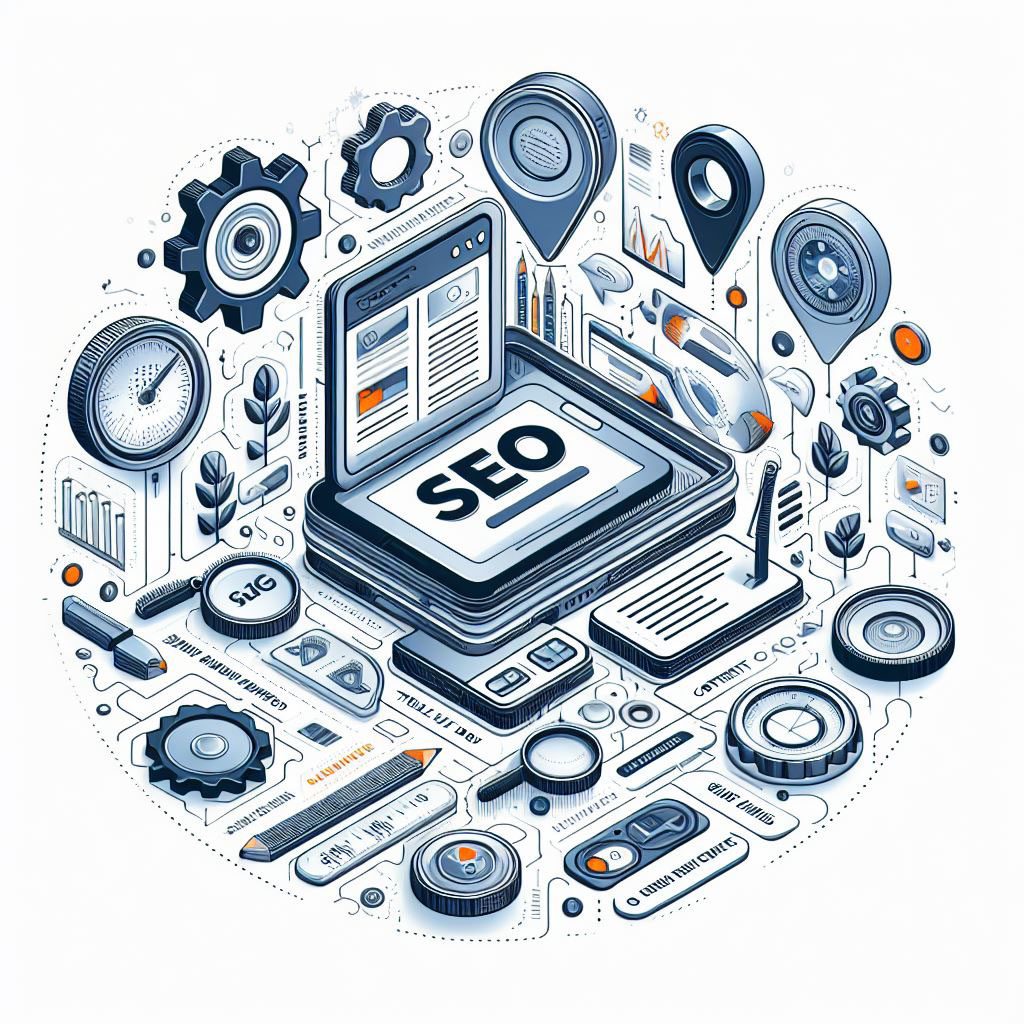1. Introduction to On-Page SEO
Search engine optimization (SEO) improves the visibility and relevance of a website or a web page in organic search results. SEO can be divided into two main categories: on-page SEO and off-page SEO.
On-page SEO (on-site SEO) refers to optimizing elements on a web page, such as content, title tags, meta descriptions, headings, images, internal links, and URLs. On-page SEO aims to make the web page more user-friendly and match the users’ search intent.
Off-page SEO (off-site SEO) refers to optimizing elements outside the web page, such as backlinks, social media, guest posting, public relations, and brand mentions. Off-page SEO aims to increase the authority and trustworthiness of the website.
On-page and off-page SEO are important for ranking higher on Google and other search engines. However, this article will focus on on-page SEO and how to master it in 2024.

2. Optimize Your Title Tags and Meta Descriptions
Title tags and meta descriptions are the first things users see when searching for something on Google. They are the main factors determining whether users will click on your web page.
Therefore, you must optimize your title tags and meta descriptions to make them catchy, relevant, and informative. Here are some tips to do that:
- Use your main keyword in your title tag and meta description, preferably at the beginning.
- Keep your title tag between 50 and 60 characters and your meta description between 150 and 160 characters.
- Use power words, numbers, and modifiers to make your title tag and meta description more appealing and specific.
- Use a call-to-action (CTA) in your meta description to encourage users to take action.
- Avoid duplicate or generic title tags and meta descriptions across your web pages.
For example, here is a reasonable title tag and meta description for a web page about on-page SEO:
Title tag: How to Master On-Page SEO in 2024 (Step-by-Step Guide)
Meta description: Learn how to optimize your web page content for search engines and users in 2024 with this comprehensive guide. Find out the factors that can make or break your SEO success, from title tags and meta descriptions to content and keywords.
3. Craft Captivating and Valuable SEO Content
Content is the king of SEO. You cannot rank well on Google or any other search engine without quality content. Content is also why users visit and stay on your web page.
Therefore, you need to craft captivating and valuable SEO content that satisfies the users’ search intent and provides them with helpful information, solutions, or entertainment. Here are some tips to do that:
- Research your target audience and their needs, problems, and preferences.
- Use keyword research tools like Bing Keyword Planner to find relevant and popular keywords for your topic.
- Use a content outline to structure your content and cover the main points and subtopics.
- Write in a clear, concise, engaging tone and style that matches your brand voice and audience.
- Use headings, subheadings, bullet points, lists, tables, charts, images, videos, and other visual elements to break up your content and make it easier to read and understand.
- Use internal links to connect your web pages and provide more value to your users.
- Use external links to cite your sources and provide more information to your users.
- Use a plagiarism checker tool like Bing Plagiarism Checker to ensure your content is original and not copied from other sources.
For example, here is a good introduction for a web page about on-page SEO:
On-page SEO is optimizing your web page content for search engines and users. It is one of the most important aspects of SEO, as it can make or break your rankings and conversions.
4. Optimize Your Content for SEO
Writing captivating and valuable content is not enough. You also need to optimize your SEO content to rank well on Google and other search engines. This means you must use your keywords strategically and naturally in your content without overusing or underusing them.
Here are some tips to optimize your content for SEO:
- Use your main keyword in your title tag, meta description, URL, and the first paragraph of your content.
- Use your main keyword and its variations in your headings, subheadings, and content, but don’t overdo it. A good rule of thumb is to use your main keyword once per 300 words.
- Use synonyms, related terms, and long-tail keywords to enrich your content and avoid keyword stuffing.
- Use Bing Keyword Density Checker to analyze your content’s keyword density and distribution and ensure it is optimal.
- Use [Bing LSI Keyword Generator] to find latent semantic indexing (LSI) keywords related to your main keyword and use them in your content to improve its relevance and context.
For example, here is a good paragraph for a web page about on-page SEO that uses keywords optimally:
One of the most important factors of on-page SEO is the title tag. The title tag is the clickable headline that appears on the search engine results page (SERP) and on the browser tab. It tells the users and the search engines what your web page is about and why they should click on it. Therefore, you must optimize your title tag to make it catchy, relevant, and informative.
5. Optimize for CTR
CTR (click-through rate) is the percentage of users who click on your web page from the search results. It is an important metric that indicates how attractive and relevant your web page is to the users.
A higher CTR can also lead to higher rankings, as Google considers it a signal of user satisfaction and quality. According to a study by Backlinko, the top result in Google’s organic search results has an average CTR of 31.7%.
Therefore, you need to optimize your web page for CTR to drive more traffic and conversions to your website. Here are some tips to do that:
- Use [Bing SERP Simulator] to preview how your web page will look on the search results and make adjustments accordingly.
- Use [Bing Search Console] to analyze your web page’s performance and identify the keywords and queries with the highest and lowest CTRs.
- Use [Bing Rich Results Test] to check if your web page is eligible for rich results, such as featured snippets, images, videos, ratings, reviews, and more. Rich results can make your web page stand out and increase your CTR.
- Use [Bing Structured Data Markup Helper] to add schema markup to your web page, a code that helps Google understand and display your content better. Schema markup can also enable rich results and enhance your CTR.
6. On-Page UX Signals
UX (user experience) signals are the indicators that measure how users interact with your web page and website. They include metrics such as bounce rate, dwell time, page views, and conversions.
UX signals are essential for on-page SEO, as they reflect the quality and value of your web page to the users. They also influence your rankings, as Google uses them to evaluate your web page’s relevance and usefulness.
Therefore, you need to optimize your web page for UX signals to provide your users with a positive and satisfying experience. Here are some tips to do that:
- Use [Bing PageSpeed Insights] to measure and improve your web page’s loading speed, which is crucial for UX and SEO. According to Google, 53% of mobile users abandon a site that takes longer than three seconds to load.
- Use [Bing Mobile-Friendly Test] to check and optimize your web page’s compatibility and responsiveness on mobile devices, which account for more than half of the web traffic worldwide.
- Use [Bing Web Vitals] to monitor and enhance your web page’s core web vitals, which are a set of metrics that measure the loading, interactivity, and visual stability of your web page. Core web vitals are also a ranking factor for Google.
- Use [Bing Analytics] to track and analyze your web page’s UX signals, such as bounce rate, dwell time, page views, and conversions. You can also use [Bing Behavior Flow] to visualize how users navigate your website and identify the highest and lowest engagement pages.
7. Conclusion
On-page SEO is optimizing your web page content for search engines and users. It is one of the most important aspects of SEO, as it can make or break your rankings and conversions.
This guide shows you how to master on-page SEO in 2024, from title tags and meta descriptions to content and keywords. We have also shared some advanced tips and tricks that most blogs don’t discuss, such as optimizing for CTR, UX signals, and rich results.
By following these steps, you can create captivating and valuable SEO content that ranks higher on Google, attracting more traffic and leads to your website.
We hope you have enjoyed this guide and learned something new. Please let us know in the comments below if you have any questions or feedback. Thank you for reading!


